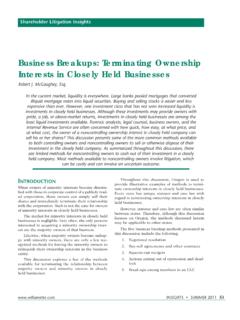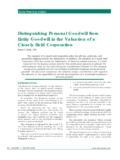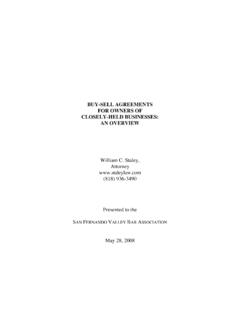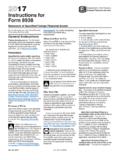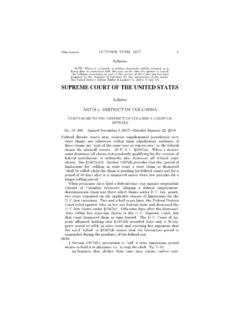Transcription of CHARITABLE PLANNING WITH CLOSELY-HELD BUSINESS …
1 CHARITABLE PLANNING WITH CLOSELY-HELD . BUSINESS INTERESTS. Jeffrey C. Thede Thede Culpepper Moore Munro & Silliman LLP. Penny H. Serrurier Stoel Rives LLP. NORTHWEST PLANNED GIVING ROUNDTABLE. ANNUAL CONFERENCE. September 16, 2016. The authors wish to thank several fellows of the American College of Trust and Estate Counsel who have had a role in developing these and related materials over the past few years, including Ed Beckwith, Turney Berry, Stephanie Casteel, Bob Collins, Bob Goldman, Martin Hall, Larry Katzenstein, Jerry McCoy, and the late Calvin Kirchik. Any errors or omissions are the authors'. own. TABLE OF CONTENTS. Page I. CHARITABLE GIFTS OF CLOSELY-HELD BUSINESS INTERESTS. GENERALLY..1. A. Valuation..1. 1. Burden of Proof..1. 2. Valuation Penalties..1. B. Substantiation..2. 1. Generally ..2. 2. Receipt Requirement ..3. 3. Appraisal Requirements..3. 4. Substantial Compliance..5. 5. Donee C. Private Foundation Rules..6. 1. Generally.
2 6. 2. Application to CHARITABLE Remainder Trusts..6. 3. Application to CHARITABLE Lead D. 1. General Rule ..6. E. Excess BUSINESS Holdings..8. 1. General Rule ..8. 2. Application to Donor Advised Funds and Supporting F. CHARITABLE Gifts to a Single-Member LLC Owned by Charity..10. II. CHARITABLE GIFTS OF C CORPORATION STOCK ..11. A. Generally..11. B. CHARITABLE C. Prearranged Redemptions and Assignment of Income Issues..11. D. Redemption for a Promissory Note..15. III. CHARITABLE GIFTS OF PARTNERSHIP (OR LLC) INTERESTS ..17. A. Donor Issues..17. 1. Phantom Income..17. 2. Bargain Sale Rules ..18. 3. Valuation and 4. Prearranged Sale Rules..18. B. Donee Issues..18. 1. Unrelated BUSINESS Income..18. 2. Debt-Financed Income..19. 3. Payments of Income Tax ..20. 4. Capital Assessments ..20. 5. Environmental Liabilities ..20. 6. Donor Indemnities..20. -i- TABLE OF CONTENTS. Page IV. CHARITABLE GIFTS OF S CORPORATION STOCK ..21. A. Before 1998..21. B. After 1.
3 Rules 2. The Good News..21. 3. The Bad News..21. V. USE OF A SUPPORTING ORGANIZATION TO HOLD S A. Conventional Approach..22. B. Use of a Supporting Organization..22. 1. CHARITABLE 2. CHARITABLE Trusts: ..23. 3. Importance of Cash Flow ..23. VI. CHARITABLE GIFTS BY THE BUSINESS ENTITY ..23. A. Generally..23. B. C C. S Corporations..24. D. Partnerships and LLCs..24. E. Impact of Section F. Contributions to CHARITABLE Remainder Trusts..25. G. Contribution of Intellectual Property to Private Foundation..25. - ii - CHARITABLE gifts involving some kind of closely held BUSINESS entity are becoming an increasingly important element of an overall estate plan. They can be an effective tool to maximize the benefits of valuation discounts, reduce income and estate taxes, a nd generally promote your client's estate PLANNING and philanthropic goals. But it is important to understand the unique tax and other implications of the gift from the perspectives of the donor, the donee, and the CLOSELY-HELD BUSINESS entity.
4 It is equally important to plan for the ultimate disposition of the BUSINESS interest will the charity hold the interest long-term, or should the plan include an appropriate "exit strategy"? The purpose of this outline is to provide something of a primer on the basic issues, and some "food for thought" on some interesting PLANNING ideas. For the most part, discussions of CHARITABLE remainder trusts, lead trusts, and gift annuities have been limited to the areas unique and pertinent to BUSINESS PLANNING . I. CHARITABLE GIFTS OF CLOSELY-HELD BUSINESS INTERESTS. GENERALLY. A. Valuation. Noncash gifts are generally valued at "fair market value," raising familiar problems of determination of value. Aggressive or fraudulent valuations of CHARITABLE contributions have been a problem since enactment of the first CHARITABLE deduction in 1917. Traditionally most of the reported decisions involved CHARITABLE gifts of artwork. As noted by the judge in a 1 984 Tax Court overvaluation case (not involving a CHARITABLE contribution), "after examining some of the paintings, we feel obliged to note that we refer to them as artwork merely for convenience.
5 " Enterprises v. Commissioner, 48 138. (1984). Recent audit data, however, confirms that the valuation of CHARITABLE gifts of BUSINESS interests is the subject of increasing IRS scrutiny. 1. Burden of Proof. As in most valuation disputes, the donor has the burden of proof in a CHARITABLE deduction case. Welch v. Halvering, 290 111. (1933); Lamphere, 70 391 (1978). See also Holtzman, 40 350 (1980). 2. Valuation Penalties. a. Substantial Valuation Misstatement. The "accuracy-related". penalties of IRC section 6662 apply to CHARITABLE contributions. There is a 20 percent penalty on any underpayment of tax (in excess of $5,000) resulting from a "substantial valuation misstatement" if the value or tax basis of any property claimed on an income tax return is 150 percent or more of the correct amount (or stated another way, if the correct value is two-thirds or less of the claimed value). IRC 6662(e)(1)(A). (Before enactment of the Pension Protection Act of 2006 ("PPA 2006"), generally effective for returns filed after August 17, 2006, the threshold was 200 percent ( , if the correct value is 50 percent or less of the claimed value).)
6 {00347516; 1} -1- b. Gross Valuation Misstatement. The penalty increases to 40. percent on any underpayment of tax (in excess of $5,000) resulting from a "gross valuation misstatement" if the reported value or basis is 200 percent or more of the correct amount ( , if the correct value is 50 percent or less of the claimed value). IRC. 6662(h). (Before PPA 2006, the threshold was 400 percent ( , if the correct value is 25 percent or less of the claimed value).). c. Other Taxpayer Penalties. Fraud penalties of 75 percent can be imposed on any underpayment of tax attributable to fraud. IRC. 6663. Criminal penalties are also possible. IRC 7206 and 7207. d. Reasonable Cause Exception. Most underpayment penalties provide a general exception if the taxpayer can show "reasonable cause" and "good faith." IRC 6664(c)(1). The exception is completely inapplicable, however, to "gross" overvaluations of " CHARITABLE deduction property" (property for which a CHARITABLE deduction is claimed), and to "substantial" overvaluations unless the donor can demonstrate that (1) the claimed value of the property was based on a "qualified appraisal made by a qualified appraiser" and (2) the donor made a "good faith investigation of the value of the contributed property.
7 " IRC 6664(c)(3). e. Appraiser Penalties. There are also penalties for appraisers who value property at a value that is 150 percent or more than the correct value ( , subject to either of the valuation misstatement penalties) if the appraiser knows, or reasonably should have known, that the appraisal would be used in connection with a tax return. IRC 6695A(a). The amount of the penalty is the greater of 10 percent of the underpayment or $1,000, but with a maximum of 125 percent of the appraisal fee received by the appraiser. IRC. 6695A(b). There is an exception if the appraiser can establish to the satisfaction of the IRS that the appraised value was "more likely than not the proper value" (whatever that means). IRC. 6695(c). B. Substantiation. 1. Generally. On several occasions since 1982, Congress has imposed increasingly stringent rules for the verification and reporting of CHARITABLE contributions. In most cases, the penalty for noncompliance is the complete disallowance of an income tax CHARITABLE deduction.
8 (There are no comparable requirements for the gift and estate tax CHARITABLE deductions, but the donor must submit such data as may be requested by the IRS. Treas. Reg. (c) and (a)-1(c).) Separate rules exist for cash contributions, contributions of property with a value of less than $500, contributions of property with a value of less than $5,000, {00347516; 1} -2- contributions of property with a value in excess of $5,000, and contributions of artwork with a value in excess of $20,000. 2. Receipt Requirement. Since 1993, no CHARITABLE deduction is allowable for any contribution of cash or other property with a value of $250 or more unless the donor obtains a "contemporaneous written acknowledgement". from the donee organization, regardless of how reliable the donor's records otherwise may be. IRC 170(f)(8)(A). The required acknowledgment must include a variety of information relating to the gift, and it must be received by the donor before the earlier of (1) the date of filing the donor's tax return claiming the deduction or (2) the due date (including extensions) for filing the return.
9 IRC 170(f)(8)(B), (C). This is rarely a problem in the case of gifts to public charities, which generally issue acceptable receipts as a matter of course, but the Service does not take kindly to receipts that do not contain all essential information required by the statute (see, , Durden v. Commissioner, Memo. 2012-140. (2012); DiDonato v. Commissioner, Memo. 2011-153 (2011)). a. This rule applies to gifts to private foundations, even to trust-form private foundations of which the donor is the sole trustee. Compliance with the rule in this case would thus literally require the donor as trustee to give a receipt to him or herself. b. In the case of CHARITABLE gifts by S Corporations or partnerships, the entity is treated as the taxpayer for substantiation purposes, so the shareholder or partner is not required to obtain any additional substantiation for his or her share of the contribution. Treas. Reg. (f)(15). c. The receipt requirement does not apply to gifts to CHARITABLE remainder trusts, but it does apply to transfers to pooled income funds.
10 Treas. Reg. (f)(13). 3. Appraisal Requirements. Section 155 of the Tax Reform Act of 1984. imposed new procedures for verification and substantiation of contributions of property (other than cash or most publicly traded securities) with a claimed value of more than $5,000. Section 155 was not made a part of the Internal Revenue Code, but rather merely directed the Secretary of the Treasury to prescribe regulations. The basic requirement is now codified in IRC sections 170(f)(11)(C) and (D). Under these substantiation rules, the donor must obtain a "qualified appraisal" of the contributed property from a "qualified appraiser," and attach an "appraisal summary" (IRS Form 8283) to the income tax return claiming a CHARITABLE deduction. Treas. Reg. (c)(2). a. The $5,000 threshold for property gifts subject to appraisal is determined on an annual basis, and the donor must take into account all gifts of the same or "similar" items and property donated during the year, whether or not donated to the same organization.
